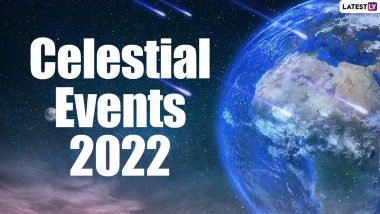Celestial Events in Astronomy Calendar 2022: Each year brings infrequent and unmissable celestial events like eclipses, meteor showers, periodic comets, different phases of the moon, comet flybys, solstices, equinoxes, planetary oppositions, and conjunctions of the planets. Galaxies are boundless cosmic islands of dust particles, stars, gas, and dark matter everything held together by gravity. The whole universe is covered in islands of matter and mysterious things. Nostradamus Predictions For 2022: From Asteroid to Political Assassination and Artificial Intelligence to Civil War, These Are the Prophecies by Legendary Astrologer.
Most of the celestial events can be seen with the naked eye, although some may require specific technical equipment like a good pair of binoculars or special telescopes for perfect viewing. If you are curious and on the case of exploring different Astro events and phenomena for the upcoming new year 2022, then go on reading further.
Notable Celestial Events In Our Solar System For The Calendar Year 2022
1. January
- Jan 2: New moon phase
- Jan 3-4: Quadrantids Meteor Shower 2022
- Jan 7: Mercury At Greatest Eastern Elongation (The planet Mercury will be at its highest point above the horizon in the evening sky)
- Jan 17: Full Moon Phase (Wolf Moon)
2. February
- Feb 1: New moon phase
- Feb 16: Full Moon Phase, Snow Moon (The moon is named this way because the heaviest snows usually fell during this time of the year. At times this phase of the moon is also referred to as "Hunger Moon")
- Feb 16: Mercury at Greatest Western Elongation
3. March
- March 18 - Full Moon (This Moon phase is named as at this particular time of the year the ground would begin to soothe and the earthworms would reappear. Also, the March Full Moon can also be termed as-Crow Moon, the Crust Moon, the Sap Moon, and the Lenten Moon)
- March 20 - March Equinox (The first day of spring in the Northern Hemisphere and the first day of Autumn in the Southern Hemisphere when the Sun will gleam directly on the equator and there will be nearly equal amounts of day and night period throughout the globe)
4. April
- Apr 16: Full moon phase, Pink Moon (This moon will be located on the opposite side of the Earth as the Sun and its face will be fully illuminated during this phase. This moon phase is also referred to as the Sprouting Grass Moon, the Growing Moon, and the Egg Moon)
- April 30 - Partial Solar Eclipse (During this eclipse the Moon will cover only a part of the Sun)
5. May
- May 16 - Total Lunar Eclipse (During this time the Moon will gradually get darker and then take on a rusty or blood red colour)
6. June
- June 14 - Full Moon, Supermoon (This moon phase is also called the Strawberry Moon because it signalled the time of year to gather ripening fruit)
- June 21 - June Solstice (First Day of summer in the Northern Hemisphere and the first day of winter in the southern hemisphere)
7. July
- July 13 - Full Moon, Supermoon (Also known as, Thunder Moon and the Hay Moon)
- July 28, 29 - Delta Aquarids Meteor Shower (This shower typically provides a decent number of meteors for some days after and before the given date. Meteors will radiate from the constellation Aquarius and the best time to view the same is after midnight in a dark location)
8. August
- August 12 - Full Moon, Supermoon (Also termed as Sturgeon Moon, Green Corn Moon, and the Grain Moon)
- August 12, 13 - Perseids Meteor Shower
- August 14 - Saturn at Opposition (Saturn will rise in the east around sunset and its face will be fully illuminated by the Sun. With the help of a medium-sized or larger telescope, you will see Saturn's rings and a few of its brightest moons)
- August 27 - Mercury at Greatest Eastern Elongation
9. September
- Sep 16: Neptune at Opposition (The blue giant planet will be visible all night long, but just like a tiny blue dot that too through a powerful telescope)
- September 23 - September Equinox
- September 26 - Jupiter at Opposition (A good pair of binoculars and a medium-sized telescope will allow you to see Jupiter's four largest moons and some details in Jupiter's cloud bands)
10. October
- Oct 7: Draconids Meteors (The Draconids are short-lived and produce 10 meteors per hour. Meteors will radiate from the constellation Draco and it will be visible in a dark location on the outskirts of the city)
- October 21, 22 - Orionids Meteor Shower (This meteor shower is basically the leftover bits and pieces of debris left by the world-famous Halley's comet)
- October 25 - Partial Solar Eclipse (In this eclipse the moon will cover only a part of the sun. It will be best seen in parts of western Russia and Kazakhstan)
10. November
- November 4, 5 - Taurids Meteor Shower (Unfortunately, next year the nearly full moon will block out all but the brightest meteors. Meteors will radiate from the constellation Taurus but can be viewed anywhere in the sky)
- November 8 - Total Lunar Eclipse (In this particular lunar eclipse the Moon passes completely through the Earth's dark shadow, also known as the umbra, and will eventually get darker with rusty red colour)
- November 9 - Uranus at Opposition (During this period the planet will appear as a little green dot through a special telescope as it will be near the earth)
- November 17, 18 - Leonids Meteor Shower (The average shower meteors will radiate from the constellation Leo, and can be seen anywhere in the sky)
12. December
- December 8 - Full Moon (Long Nights Moon and the Moon Before Yule)
- December 8 - Mars at Opposition (The red planet will be visible all night long and can be seen through a medium-sized telescope to explore the dark details in the orange surface of the planet)
- December 13, 14 - Geminids Meteor Shower (These meteors tend to be bold, white, and quick and manage to surpass the moonlight. Geminids Meteors will radiate from the constellation Gemini next year)
- December 21 - December Solstice
- December 21, 22 - Ursids Meteor Shower
Jot down all your favourite Astro event so that you don't miss even a single magical scenario in the sky. Happy Viewing!
(The above story first appeared on LatestLY on Dec 31, 2021 10:37 AM IST. For more news and updates on politics, world, sports, entertainment and lifestyle, log on to our website latestly.com).













 Quickly
Quickly












